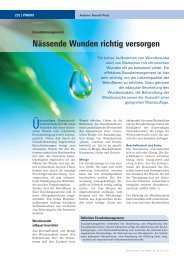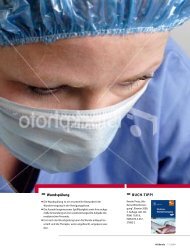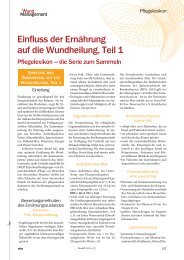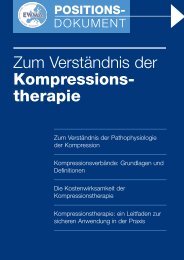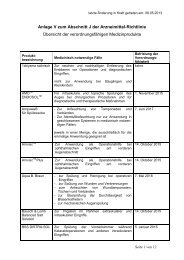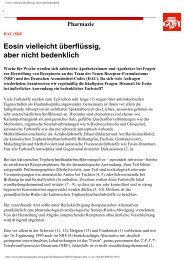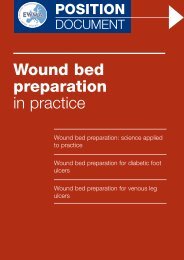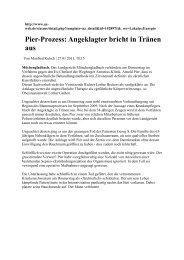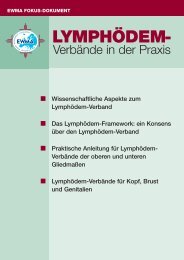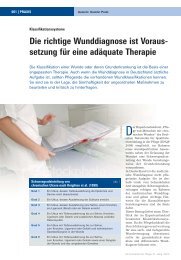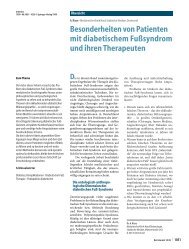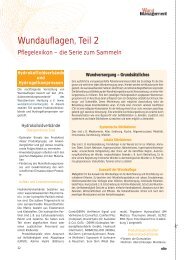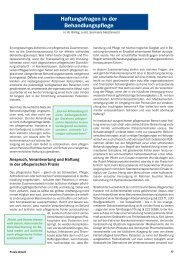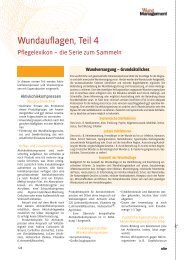Minimising pain at wound dressing-related procedures A ... - Less Pain
Minimising pain at wound dressing-related procedures A ... - Less Pain
Minimising pain at wound dressing-related procedures A ... - Less Pain
You also want an ePaper? Increase the reach of your titles
YUMPU automatically turns print PDFs into web optimized ePapers that Google loves.
Preparing the environment: Prepare, Plan, Prevent<br />
In order to Prevent <strong>pain</strong>, Prepar<strong>at</strong>ion and Planning are key to effective management:<br />
■ Choose an appropri<strong>at</strong>e non-stressful environment – close windows, turn off mobile<br />
phones etc<br />
■ Explain to the p<strong>at</strong>ient in simple terms wh<strong>at</strong> will be done and the method to be used<br />
■ Assess the need for skilled or unskilled assistance, such as help with simple hand-holding<br />
■ Be thoughtful in positioning the p<strong>at</strong>ient to minimise discomfort and avoid unnecessary<br />
contact or exposure<br />
■ Avoid prolonged exposure of the <strong>wound</strong>, eg waiting for specialist advice<br />
■ Avoid any unnecessary stimulus to the <strong>wound</strong> – handle <strong>wound</strong>s gently, being aware th<strong>at</strong><br />
any slight touch can cause <strong>pain</strong><br />
■ Involve the p<strong>at</strong>ient throughout – frequent verbal checks and use of <strong>pain</strong> tools offer realtime<br />
feedback<br />
■ Consider prevent<strong>at</strong>ive analgesia.<br />
In some cases, <strong>dressing</strong>-rel<strong>at</strong>ed <strong>procedures</strong> can become more <strong>pain</strong>ful over time and a new<br />
assessment must be undertaken each time the procedure is carried out.<br />
The simplest outcome of listening to and involving the p<strong>at</strong>ient is a prompt for ‘time-out’<br />
breaks to allow the p<strong>at</strong>ient’s comfort levels to recover. At this time analgesia can be<br />
supplemented and the clinician, who needs to understand wh<strong>at</strong> the p<strong>at</strong>ient recognises as<br />
triggering the <strong>pain</strong> and wh<strong>at</strong> brings relief, can consider how best to proceed. Slow rhythmic<br />
bre<strong>at</strong>hing is recommended to distract the p<strong>at</strong>ient and reduce anxiety.<br />
PROCEDURAL INTERVENTIONS<br />
There are a vast array of <strong>dressing</strong>-rel<strong>at</strong>ed <strong>procedures</strong>. Specific interventions will require specific<br />
management, but the following general principles should be considered:<br />
■ Be aware of current st<strong>at</strong>us of <strong>pain</strong><br />
■ Know and avoid, where possible, <strong>pain</strong> triggers<br />
■ Know and use, where possible, <strong>pain</strong> reducers<br />
■ Avoid unnecessary manipul<strong>at</strong>ion of the <strong>wound</strong><br />
■ Explore simple p<strong>at</strong>ient-controlled techniques, such as counting up and down, focusing on the<br />
bre<strong>at</strong>h entering and leaving the lungs or listening to music<br />
■ Reconsider management choices if <strong>pain</strong> becomes intolerable and document as an adverse<br />
event<br />
■ Observe the <strong>wound</strong> and the surrounding skin for evidence of infection, necrosis,<br />
macer<strong>at</strong>ion etc<br />
■ Consider the temper<strong>at</strong>ure of the product or solution before applying to the <strong>wound</strong><br />
■ Avoid excessive pressure from a <strong>dressing</strong>, bandage or tape<br />
■ Follow the manufacturer’s instructions when using a <strong>dressing</strong> or technology<br />
■ Assess comfort of intervention and/or <strong>dressing</strong>/bandages applied after the procedure<br />
■ Ongoing evalu<strong>at</strong>ion and modific<strong>at</strong>ion of the management plan and tre<strong>at</strong>ment intervention is<br />
essential as <strong>wound</strong>s change over time<br />
■ More advanced non-pharmacological techniques th<strong>at</strong> require specialist training or skilled<br />
personnel, such as the use of hypnosis or therapeutic touch, can be considered<br />
8 | PRINCIPLES OF BEST PRACTICE




